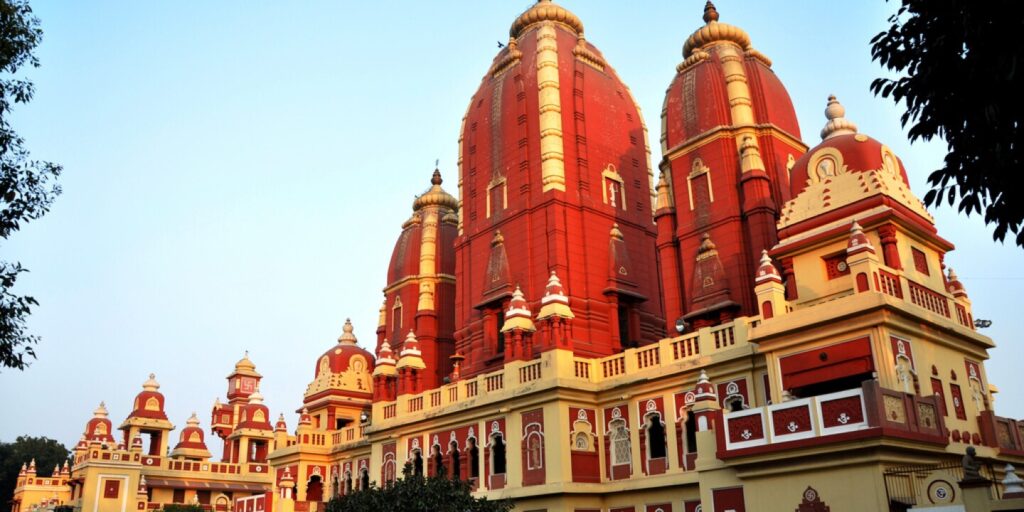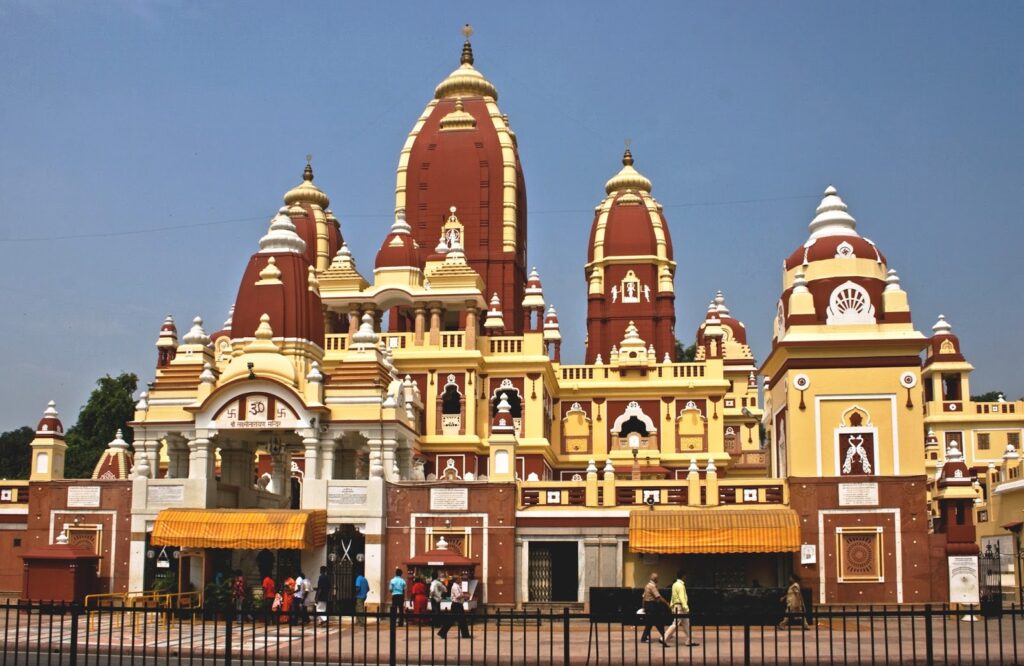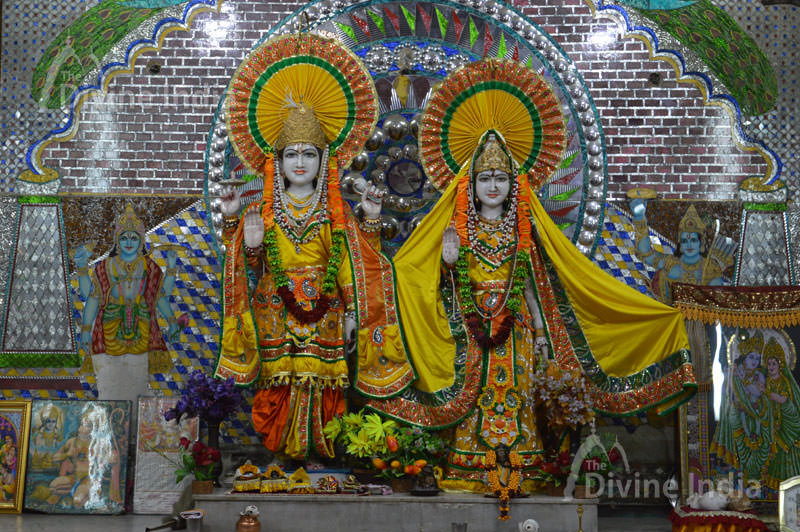
Laxminarayan Temple (Birla Mandir), Delhi
This temple commonly known as Birla Mandir, is a prominent Hindu temple located in the heart of New Delhi, India. Built by the industrialist Birla family, the temple is dedicated to Lord Vishnu, the preserver in the Hindu trinity. Constructed in the early 20th century, it stands as a testament to modern Indian temple architecture. The temple complex not only houses the main shrine of Laxminarayan but also includes several other shrines, fountains, and a large garden. The white marble façade, adorned with intricate carvings and sculptures, adds to the temple’s grandeur. The sanctum sanctorum is graced by beautifully crafted idols of Lord Vishnu and his consort, Goddess Lakshmi. The serene ambiance and spiritual atmosphere make the Laxminarayan Temple a popular destination for both devotees and tourists seeking a tranquil retreat in the bustling capital city of India. Beyond its religious significance, the temple stands as a cultural and architectural marvel, attracting visitors with its captivating beauty and historical importance.
Historical background and Architectural splendor
This temple has a rich historical background intertwined with India’s socio-economic landscape. Commissioned by the prominent industrialist and philanthropist, Baldeo Das Birla, and inaugurated by Mahatma Gandhi in 1939, the temple stands as a symbol of unity and the vision for a modern India. Dedicated to Lord Vishnu, the preserver in Hinduism, and his consort, Goddess Lakshmi, the temple was conceived to promote a sense of national integration.
Architecturally, the Laxminarayan Temple is a splendid example of the Nagara style of temple architecture, primarily seen in North India. The temple’s exterior is crafted from white marble, which not only imparts a sense of purity but also reflects the sunlight, creating a radiant appearance. The intricate carvings and sculptures depict various mythological themes, showcasing the skilled craftsmanship of the artisans. The central shrine houses impressively adorned idols of Lord Vishnu and Goddess Lakshmi, adding to the temple’s visual opulence.
The architectural splendor extends to the lush garden surrounding the temple, providing a serene environment for visitors. The temple complex also incorporates other shrines dedicated to various deities, contributing to the spiritual diversity of the site. The blend of historical significance, cultural resonance, and architectural excellence makes the Laxminarayan Temple a significant landmark in Delhi, drawing both devotees and admirers of art and heritage alike.

Religious Significance
The Laxminarayan Temple, or Birla Mandir, holds profound religious significance in the spiritual landscape of Delhi. Dedicated to Lord Vishnu, the preserver in Hinduism, and his consort, Goddess Lakshmi, the temple is a sacred space where devotees come to seek blessings, solace, and spiritual rejuvenation. The deity, Laxminarayan, is revered as a symbol of wealth, prosperity, and preservation of the universe. Devotees believe that offering prayers and paying homage at the temple can bring divine grace, peace, and fulfillment of wishes. The sanctum sanctorum, adorned with exquisitely crafted idols of Lord Vishnu and Goddess Lakshmi, becomes a focal point for religious rituals and ceremonies. The temple's serene ambiance and tranquil surroundings create an atmosphere conducive to meditation and spiritual reflection.

Festival and Celebrations
This temple celebrates various Hindu festivals with grandeur and devotion. Some of the prominent festivals observed at the temple include Janmashtami,Diwali, Holi, Ram Navami, Navaratri and Durga Puja and Vishnu Vivah: During these festivals, the temple becomes a hub of religious and cultural activities, drawing both devotees and tourists. The celebrations reflect the vibrant spirit of Hindu traditions and provide an opportunity for the community to come together in prayer and festivity.
Surroundings area & attractions
- ISKCON Temple (Hare Krishna Temple): Located in the East of Kailash, the ISKCON Temple is dedicated to Lord Krishna and is a vibrant center for spiritual activities, including devotional chanting and worship.
- Jama Masjid: One of the largest mosques in India, Jama Masjid is a significant Islamic religious site located in Old Delhi. It attracts a large number of devotees for prayers and religious gatherings.
- Gurdwara Bangla Sahib: A prominent Sikh gurdwara located in Connaught Place, it is known for its sacred pond and serves as a spiritual center for the Sikh community.
- Chhatarpur Temple: Dedicated to Goddess Katyayani, Chhatarpur Temple is one of the largest temple complexes in Delhi, featuring beautiful architecture and serene surroundings.
Visitor information
Entry Fee: No fee
Timings :
- 4:30 am to 1:30 pm
- 2:30 pm to 9:00 pm
Darshan Days- All days
Address:
:Laxminarayan Temple (Birla Mandir) Mandir Marg, Near Gol Market, New Delhi - 110001, India.
Notable Events and Incidents
- Construction and Inauguration
- Post-Independence Re-consecration
Connectivity :
- Road: Easily accessible by taxis, auto-rickshaws, and private vehicles through Delhi's well-developed road network.
- Metro: Conveniently connected to the Delhi Metro network, with the nearest station being Ramakrishna Ashram Marg Metro Station.
- Rail: Accessible for those arriving at New Delhi Railway Station; local transportation options like taxis or metro can be used from there.
- Air: Convenient for air travelers, as Indira Gandhi International Airport serves as the major airport, with taxis and transportation services available for the journey to Laxminarayan Temple.
FAQ
The Mahakaleshwar Jyotirlinga is one of the twelve Jyotirlingas, the most sacred abodes of Lord Shiva. It is located in Ujjain in the Indian state of Madhya Pradesh. The temple is also known as Mahakal Mandir.
The temple is situated in the heart of Delhi, near Connaught Place, on Mandir Marg. Its central location makes it easily accessible to visitors from various parts of the city.
The temple was built by industrialist and philanthropist B. R. Birla and his sons in 1939. It was inaugurated by Mahatma Gandhi, the father of the nation, and is managed by the Birla family trust.
The temple showcases a blend of traditional Hindu temple architecture with modern influences. It features intricate carvings, sculptures, and marble work, reflecting the craftsmanship of skilled artisans.
The primary deities enshrined in the temple are Lord Vishnu (Narayan) and his consort Goddess Lakshmi (Laxmi). The temple also houses other deities such as Lord Shiva, Lord Ganesha, and Goddess Durga.
The temple is usually open to visitors from early morning to late evening.
No, there is no entry fee to visit the temple.
While there isn’t a strict dress code enforced, visitors are advised to dress modestly and respectfully.
Photography and videography are usually allowed inside the temple premises, but it’s advisable to inquire with the temple authorities.
Visitors are expected to maintain decorum and silence inside the temple premises, as it is a place of worship and meditation.
The temple celebrates various Hindu festivals with great fervor, including Diwali, Janmashtami (the birth anniversary of Lord Krishna), Ram Navami, and Navaratri.
The temple’s strategic location in the heart of Delhi symbolizes its importance as a center of spirituality and cultural heritage. It serves as a spiritual oasis amidst the bustling city life, offering devotees a sanctuary for prayer and reflection.
Yes, the temple priests perform regular rituals and ceremonies such as Aarti (worship with lamps), Abhishekam (ritual bathing of the deity), and Bhajans (devotional singing) to the deities.
Yes, there is parking available near the temple premises for visitors arriving by car or other vehicles.
Yes, the temple accepts donations and contributions from devotees and visitors to support its maintenance and charitable activities.
Yes, the temple is wheelchair accessible, with ramps and facilities to accommodate visitors with mobility challenges.
Yes, the Laxminarayan Temple is located in close proximity to various other attractions in Delhi, including Connaught Place, India Gate, Jantar Mantar, and the National Museum. Visitors can explore these sites as part of their itinerary when visiting the temple.
Yes, the temple is beautifully illuminated with lights and decorations during special occasions, festivals, and important religious events. The grandeur of the temple during these times adds to the festive atmosphere and attracts visitors from far and wide.
Yes, guided tours of the temple are available for visitors who wish to learn more about its history, architecture, and significance.
While the temple remains open throughout the year, certain festivals and auspicious occasions such as Diwali, Janmashtami, and Navaratri are considered special occasions.
